The Dual Role of Digital Self-Efficacy in Reading Engagement from a Nonlinear Dynamics Perspective
Abstract
1. Introduction
1.1. Reading Engagement and Liking of Reading
1.2. Reading Engagement and Reading Self-Efficacy
1.3. Proposed Analytical Model to Evaluate Hypothesized Relations
1.4. Importance and Goals of This Study
2. Methodology
2.1. Participants and Procedures
2.2. Measures
2.2.1. Reading Engagement
2.2.2. Digital Self-Efficacy
2.2.3. Liking Reading
2.2.4. Reading Achievement
2.3. Data Analyses
Cusp Catastrophe Model
3. Results
3.1. Prerequisite Cusp Model Assumptions
3.2. Cusp Model Support
4. Discussion
4.1. Implications for Educational Policy
4.2. Study Limitations and Future Directions
5. Conclusions
Supplementary Materials
Author Contributions
Funding
Institutional Review Board Statement
Informed Consent Statement
Data Availability Statement
Conflicts of Interest
References
- Bandura, A. Social Foundations of Thought and Action; Prentice-Hall: Englewood Cliffs, NJ, USA, 1986. [Google Scholar]
- Bandura, A. Self-Efficacy: The Exercise of Control; Freeman: New York, NY, USA, 1997. [Google Scholar]
- Lee, Y.-H.; Wu, J.-Y. The Effect of Individual Differences in the Inner and Outer States of ICT on Engagement in Online Reading Activities and PISA 2009 Reading Literacy: Exploring the Relationship Between the Old and New Reading Literacy. Learn. Individ. Differ. 2012, 22, 336–342. [Google Scholar] [CrossRef]
- Shank, D.B.; Cotton, S.R. Does technology empower urban youth? The relationship of technology use to self-efficacy. Comput. Educ. 2014, 70, 184–193. [Google Scholar] [CrossRef]
- Boakye, N.A.N.Y. The Relationship between Self-Efficacy and Reading Proficiency of First-Year Students: An Exploratory Study. Read. Writ. 2015, 6, 1–9. [Google Scholar] [CrossRef]
- Kim, Y.; Glassman, M.; Bartholomew, M.; Hur, E.H. Creating an educational context for open source intelligence: The development of internet self-efficacy through a blogcentric course. Comput. Educ. 2013, 69, 332–342. [Google Scholar] [CrossRef]
- Tsai, C.; Chuang, S.; Liang, J.; Tsai, M. Self-efficacy in internet-based learning environments: A literature review. Educ. Technol. Soc. 2011, 14, 222–240. [Google Scholar]
- Phan, H.P. Relations between informational sources, self-efficacy and academic achievement: A developmental approach. Educ. Psychol. 2012, 32, 81–105. [Google Scholar] [CrossRef]
- Wang, M.S.; Yu, R.S.; Hu, J. The relationship between social media-related factors and student collaborative problem-solving achievement: An HLM analysis of 37 countries. Educ. Inf. Technol. 2023, 28, 14071–14089. [Google Scholar] [CrossRef]
- Zhu, J.; Li, S.C. The Non-Linear Relationships Between ICT Use and Academic Achievement of Secondary Students in Hong Kong. Comput. Educ. 2022, 187, 104546. [Google Scholar] [CrossRef]
- Goldhammer, F.; Kröhne, U. Controlling individuals’ time spent on task in speeded performance measures: Experimental time limits, posterior time limits, and response time modeling. Appl. Psychol. Meas. 2014, 38, 255–267. [Google Scholar] [CrossRef]
- Unrau, N.J.; Quirk, M. Reading motivation and reading engagement: Clarifying commingled conceptions. Read. Psychol. 2014, 35, 260–284. [Google Scholar] [CrossRef]
- Kelley, M.; Clausen-Grace, N. Facilitating engagement by differentiating independent reading. Read. Teach. 2009, 63, 313–318. [Google Scholar] [CrossRef]
- Ronimus, M.; Tolvanen, A.; Hautala, J. The roles of motivation and engagement in computer-based assessment of children’s reading comprehension. Learn. Individ. Differ. 2022, 98, 102197. [Google Scholar] [CrossRef]
- Yu, H.; Hu, J. ICT self-efficacy and ICT interest mediate the gender differences in digital reading: A multilevel serial mediation analysis. Int. J. Emerg. Technol. Learn. IJET 2022, 17, 211–225. [Google Scholar] [CrossRef]
- Wang, C.H.; Shannon, D.M.; Ross, M.E. Students’ characteristics, self-regulated learning, technology self-efficacy, and course outcomes in online learning. Distance Educ. 2013, 34, 302–323. [Google Scholar] [CrossRef]
- Lee, Y.; Cho, E.; Ha, E.; Garam, K.; Lee, A.; Capin, P.; Swanson, E. Profiles of reading mindset and self-efficacy: How are they related to achievement goals, engagement, and reading achievement? Educ. Psychol. 2022, 42, 934–951. [Google Scholar] [CrossRef]
- Winne, P.H. Self-regulated learning viewed from models of information processing. Self-Regul. Learn. Acad. Achiev. Theor. Perspect. 2001, 2, 153–189. [Google Scholar]
- Bozgün, K.; Can, F. The associations between metacognitive reading strategies and critical reading self-efficacy: Mediation of reading motivation. Int. J. Soc. Educ. Sci. 2023, 5, 51–65. [Google Scholar] [CrossRef]
- Fitri, E.; Sofyan, D.; Jayanti, F. The correlation between reading self-efficacy and reading comprehension. J. Engl. Educ. Teach. 2019, 3, 1–13. [Google Scholar] [CrossRef]
- Graham, S.; Woore, R.; Porter, A.; Courtney, L.; Savory, C. Navigating the challenges of l2 reading: Self-efficacy, self-regulatory reading strategies, and learner profiles. Mod. Lang. J. 2020, 104, 693–714. [Google Scholar] [CrossRef]
- Handayani, M.; Tantra, D.; Agustini, D. Correlation among reading interest, reading self-efficacy, and reading competency in junior high school. Int. J. Lang. Lit. 2020, 4, 140–146. [Google Scholar] [CrossRef]
- Hahnel, C.; Goldhammer, F.; Naumann, J.; Kröhne, U. Effects of linear reading, basic computer skills, evaluating online information, and navigation on reading digital text. Comput. Hum. Behav. 2016, 55, 486–500. [Google Scholar] [CrossRef]
- Jones, C.; Shao, B. The Net Generation and Digital Natives: Implications for Higher Education; Higher Education Academy: York, UK, 2011. [Google Scholar]
- Mullis, I.V.S.; Martin, M.O. PIRLS 2021 International Results in Reading; International Association for the Evaluation of Educational Achievement (IEA): Amsterdam, The Netherlands, 2022. [Google Scholar]
- Scherer, R.; Siddiq, F. The relation between students’ socioeconomic status and ICT literacy: Findings from a meta-analysis. Comput. Educ. 2019, 138, 13–32. [Google Scholar] [CrossRef]
- Leu, D.J.; Kinzer, C.K.; Coiro, J.; Castek, J.; Henry, L.A. New literacies: A dual-level theory of the changing nature of literacy, instruction, and assessment. In Theoretical Models and Processes of Reading; Alvermann, D.E., Unrau, N.J., Ruddell, R.B., Eds.; International Reading Association: Newark, DE, USA, 2013; pp. 1150–1181. [Google Scholar]
- Warschauer, M.; Matuchniak, T. New technology and digital worlds: Analyzing evidence of equity in access, use, and outcomes. Rev. Res. Educ. 2010, 34, 179–225. [Google Scholar] [CrossRef]
- Chua, Y.; Cooray, S.; Forero Cortes, J.P.; Denny, P.; Dupuch, S.; Garbett, D.L.; Nassani, A.; Cao, J.; Qiao, H.; Reis, A.; et al. Striving for Authentic and Sustained Technology Use in the Classroom: Lessons Learned from a Longitudinal Evaluation of a Sensor-Based Science Education Platform. Int. J. Hum.–Comput. Interact. 2023, 40, 5073–5086. [Google Scholar] [CrossRef]
- Sung, Y.T.; Yang, J.M.; Lee, H.Y. The effects of mobile-computer-supported collaborative learning: Meta-analysis and critical synthesis. Rev. Educ. Res. 2017, 87, 768–805. [Google Scholar] [CrossRef]
- Yang, S.J.; Quadir, B.; Chen, N.S.; Miao, Q. Effects of online presence on learning performance in a blog-based online course. Internet High. Educ. 2018, 36, 41–48. [Google Scholar] [CrossRef]
- Lampropoulos, G.; Keramopoulos, E.; Diamantaras, K.; Evangelidis, G. Augmented Reality and Gamification in Education: A Systematic Literature Review of Research, Applications, and Empirical Studies. Appl. Sci. 2022, 12, 6809. [Google Scholar] [CrossRef]
- Joksimović, S.; Dowell, N.; Poquet, O.; Kovanović, V.; Gašević, D.; Dawson, S.; Graesser, A.C. Exploring Development of Social Capital in a CMOOC Through Language and Discourse. Internet High. Educ. 2018, 36, 54–64. [Google Scholar] [CrossRef]
- Owston, R.; York, D.N. The Nagging Question When Designing Blended Courses: Does the Proportion of Time Devoted to Online Activities Matter? Internet High. Educ. 2018, 36, 22–32. [Google Scholar] [CrossRef]
- Sun, Z.; Xie, K.; Anderman, L.H. The Role of Self-Regulated Learning in Students’ Success in Flipped Undergraduate Math Courses. Internet High. Educ. 2018, 36, 41–53. [Google Scholar] [CrossRef]
- Barberg, J. The Effect of Choice in Reading: Motivation, Engagement, and Enjoyment. Master’s Thesis, Minnesota State University Moorhead, Moorhead, MN, USA, 2022. [Google Scholar]
- Guthrie, J.T.; Wigfield, A.; VonSecker, C. Effects of integrated instruction on motivation and strategy use in reading. J. Educ. Psychol. 2000, 92, 331. [Google Scholar] [CrossRef]
- Wang, X.W.; Zhu, Y.J.; Zhang, Y.C. An empirical study of college students’ reading engagement on academic achievement. Front. Psychol. 2022, 13, 1025754. [Google Scholar]
- Mol, S.E.; Bus, A.G. To read or not to read: A meta-analysis of print exposure from infancy to early adulthood. Psychol. Bull. 2011, 137, 267. [Google Scholar] [CrossRef]
- Naumann, J.; Goldhammer, F. Time-on-Task Effects in Digital Reading Are Non-Linear and Moderated by Persons’ Skills and Tasks’ Demands. Learn. Individ. Differ. 2017, 53, 1–16. [Google Scholar] [CrossRef]
- Goldhammer, F.; Naumann, J.; Keßel, Y. Assessing individual differences in basic computer skills: Psychometric characteristics of an interactive performance measure. Eur. J. Psychol. Assess. 2013, 29, 263–275. [Google Scholar] [CrossRef]
- Goldhammer, F.; Naumann, J.; Stelter, A.; Tóth, K.; Rölke, H.; Klieme, E. The time on- task effect in reading and problem solving is moderated by task difficulty and skill: Insights from a computer-based large-scale assessment. J. Educ. Psychol. 2014, 106, 608–626. [Google Scholar] [CrossRef]
- Greiff, S.; Niepel, C.; Scherer, R.; Martin, R. Understanding students’ performance in a computer-based assessment of complex problem solving. An analysis of behavioral data from computer-generated log files. Comput. Hum. Behav. 2016, 61, 36–46. [Google Scholar] [CrossRef]
- Zimmerman, B.J. Self-efficacy: An essential motive to learn. Contemp. Educ. Psychol. 2000, 25, 82–91. [Google Scholar] [CrossRef]
- Falck, O.; Mang, C.; Woessmann, L. Virtually no effect? Different uses of classroom computers and their effect on student achievement. Oxf. Bull. Econ. Stat. 2018, 80, 1–38. [Google Scholar] [CrossRef]
- Lorena, S.; Argentin, G.; Gui, M.; Origo, F.; Pagani, L.; Comi, S.L.; Argentin, G.; Gui, M.; Origo, F.; Pagani, L.; et al. Is it the way they use it? Teachers, ICT and student achievement. Econ. Educ. Rev. 2017, 56, 24–39. [Google Scholar] [CrossRef]
- Ferla, J.; Valcke, M.; Cai, Y. Academic self-efficacy and academic self-concept: Reconsidering structural relationships. Learn. Individ. Differ. 2009, 19, 499–505. [Google Scholar] [CrossRef]
- Chen, F.; Sakyi, A.; Cui, Y. Identifying key contextual factors of digital reading literacy through a machine learning approach. J. Educ. Comput. Res. 2022, 60, 1763–1795. [Google Scholar] [CrossRef]
- Shell, D.; Colvin, C.; Bruning, R. Self-efficacy, attribution, and outcome expectancy mechanisms in reading and writing achievement: Grade-level and achievement-level differences. J. Educ. Psychol. 1995, 87, 386–398. [Google Scholar] [CrossRef]
- Ghabdian, F.; Ghafournia, N. The relationship between Iranian EFL learners’ self-efficacy beliefs and reading comprehension ability. Engl. Linguist. Res. 2016, 5, 38–50. [Google Scholar] [CrossRef]
- Mullis, I.V.S.; Martin, M.O.; Liu, J. Mullis, I.V.S., Martin, M.O., Eds.; PIRLS 2021 context questionnaire framework. In PIRLS 2021 Assessment Frameworks; International Association for the Evaluation of Educational Achievement: Amsterdam, The Netherlands, 2019; pp. 27–56. Available online: https://timssandpirls.bc.edu/pirls2021/frameworks/ (accessed on 24 February 2025).
- Masters, G.N. A Rasch model for partial credit scoring. Psychometrika 1982, 47, 149–174. [Google Scholar] [CrossRef]
- Bezirhan, U.; Foy, P.; von Davier, M. PIRLS 2021 sampling and weighting methodology. In Methods and Procedures: PIRLS 2021 Technical Report; International Association for the Evaluation of Educational Achievement (IEA): Amsterdam, The Netherlands, 2021; Available online: https://timssandpirls.bc.edu/pirls2021/ (accessed on 24 February 2025).
- Masters, G.N. Partial credit model. In Handbook of Item Response Theory; Chapman and Hall/CRC: Boca Raton, FL, USA, 2016; pp. 137–154. [Google Scholar]
- Thom, R. Structural Stability and Morphogenesis; CRC Press: Boca Raton, FL, USA, 1975. [Google Scholar]
- Hardy, L. Testing the predictions of the cusp catastrophe model of anxiety and performance. Sport Psychol. 1996, 10, 140–156. [Google Scholar] [CrossRef]
- Scheffer, M.; Carpenter, S.; Foley, J.A.; Folke, C.; Walker, B. Catastrophic shifts in ecosystems. Nature 2001, 413, 591–596. [Google Scholar] [CrossRef]
- Poston, T.; Stewart, I. Catastrophe Theory and Its Applications; Courier Corporation: Pitman, NJ, USA, 1978. [Google Scholar]
- Grasman, R.; Maas, H.L.; Wagenmakers, E.J. Fitting the cusp catastrophe in R: A cusp package primer. J. Stat. Softw. 2010, 32, 1–27. [Google Scholar]
- Muthukrishna, M.; Henrich, J.; Toyokawa, W.; Hamamura, T.; Kameda, T.; Heine, S.J. Overconfidence Is Universal? Elicitation of Genuine Overconfidence (EGO) Procedure Reveals Systematic Differences across Domain, Task Knowledge, and Incentives in Four Populations. PLoS ONE 2018, 13, e0202288. [Google Scholar] [CrossRef]
- Pieger, E.; Mengelkamp, C.; Bannert, M. Fostering Analytic Metacognitive Processes and Reducing Overconfidence by Disfluency: The Role of Contrast Effects. Appl. Cognit. Psychol. 2017, 31, 291–301. [Google Scholar] [CrossRef]
- Kruger, J.; Dunning, D. Unskilled and unaware of it: How difficulties in recognizing one’s own incompetence lead to inflated self-assessments. J. Pers. Soc. Psychol. 1999, 77, 1121. [Google Scholar] [CrossRef] [PubMed]
- Rachmatullah, A.; Ha, M. Examining High-School Students’ Overconfidence Bias in Biology Exam: A Focus on the Effects of Country and Gender. Int. J. Sci. Educ. 2019, 41, 652–673. [Google Scholar] [CrossRef]
- Eastin, M.S.; LaRose, R. Internet self-efficacy and the psychology of the digital divide. J. Comput. Commun. 2000, 6, 611. [Google Scholar] [CrossRef]
- Sheldrake, R. Differential Predictors of Under-Confidence and Over-Confidence for Mathematics and Science Students in England. Learn. Individ. Differ. 2016, 49, 305–313. [Google Scholar] [CrossRef][Green Version]
- Moore, D.A.; Healy, P.J. The Trouble with overconfidence. Psychol. Rev. 2008, 115, 502–517. [Google Scholar] [CrossRef]
- Guastello, S. Moderator regression and the cusp catastrophe: Application of two-stage personnel selection, training, therapy, and policy evaluation. Behav. Sci. 1982, 27, 259–272. [Google Scholar] [CrossRef]
- Guastello, S. Cusp and butterfly catastrophe modeling of two opponent process models: Drug addiction and work performance. Behav. Sci. 1984, 29, 258–262. [Google Scholar] [CrossRef]
- Cobb, L.; Zacks, S. Applications of Catastrophe Theory for Statistical Modeling in the Biosciences. J. Am. Stat. Assoc. 1985, 80, 793–802. [Google Scholar] [CrossRef]
- Brenner, L. Should Observed Overconfidence Be Dismissed as a Statistical Artifact? Critique of Erev, Wallsten, and Budescu (1994). Psychol. Rev. 2000, 107, 943–946. [Google Scholar] [CrossRef]
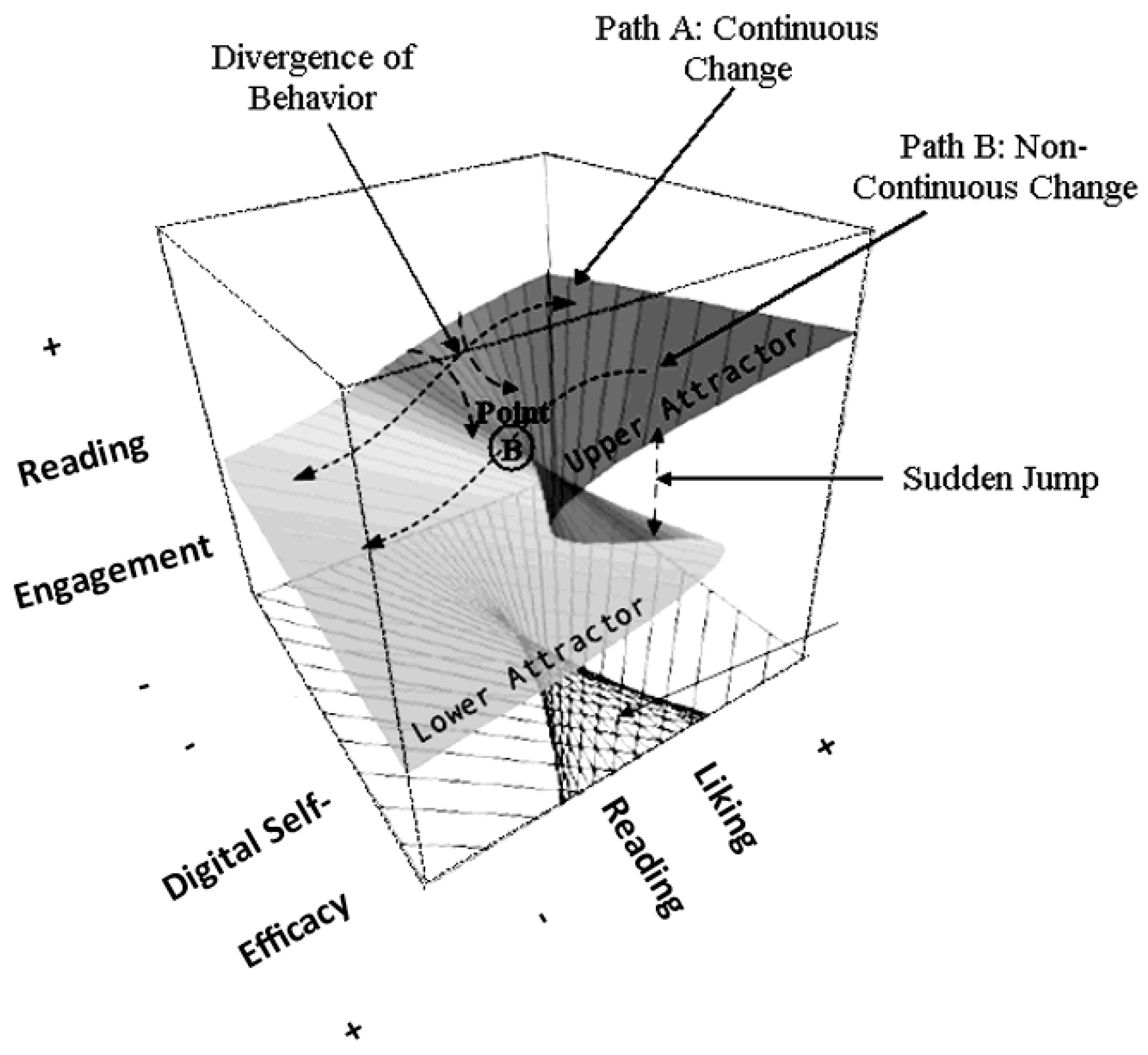
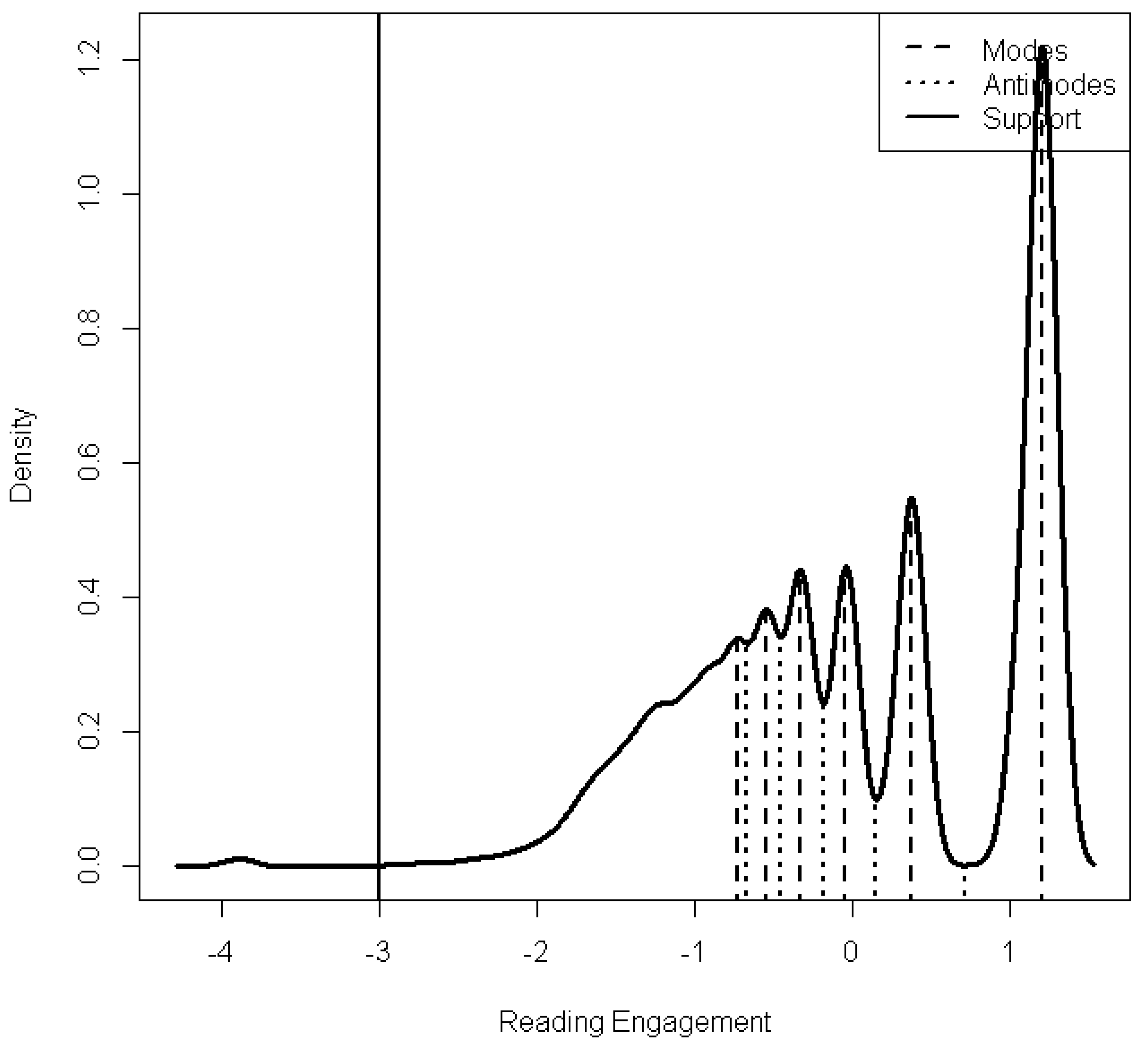
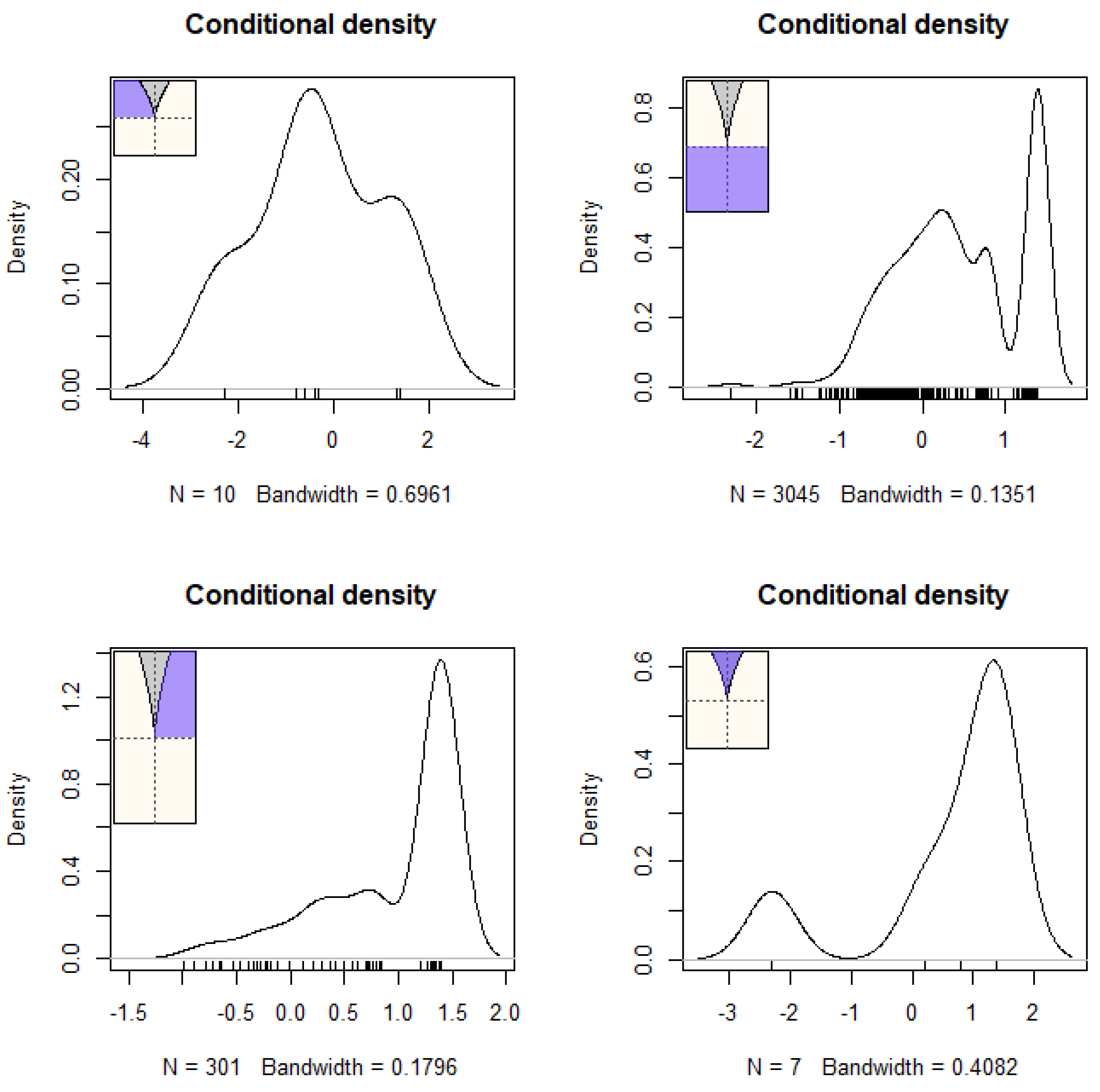
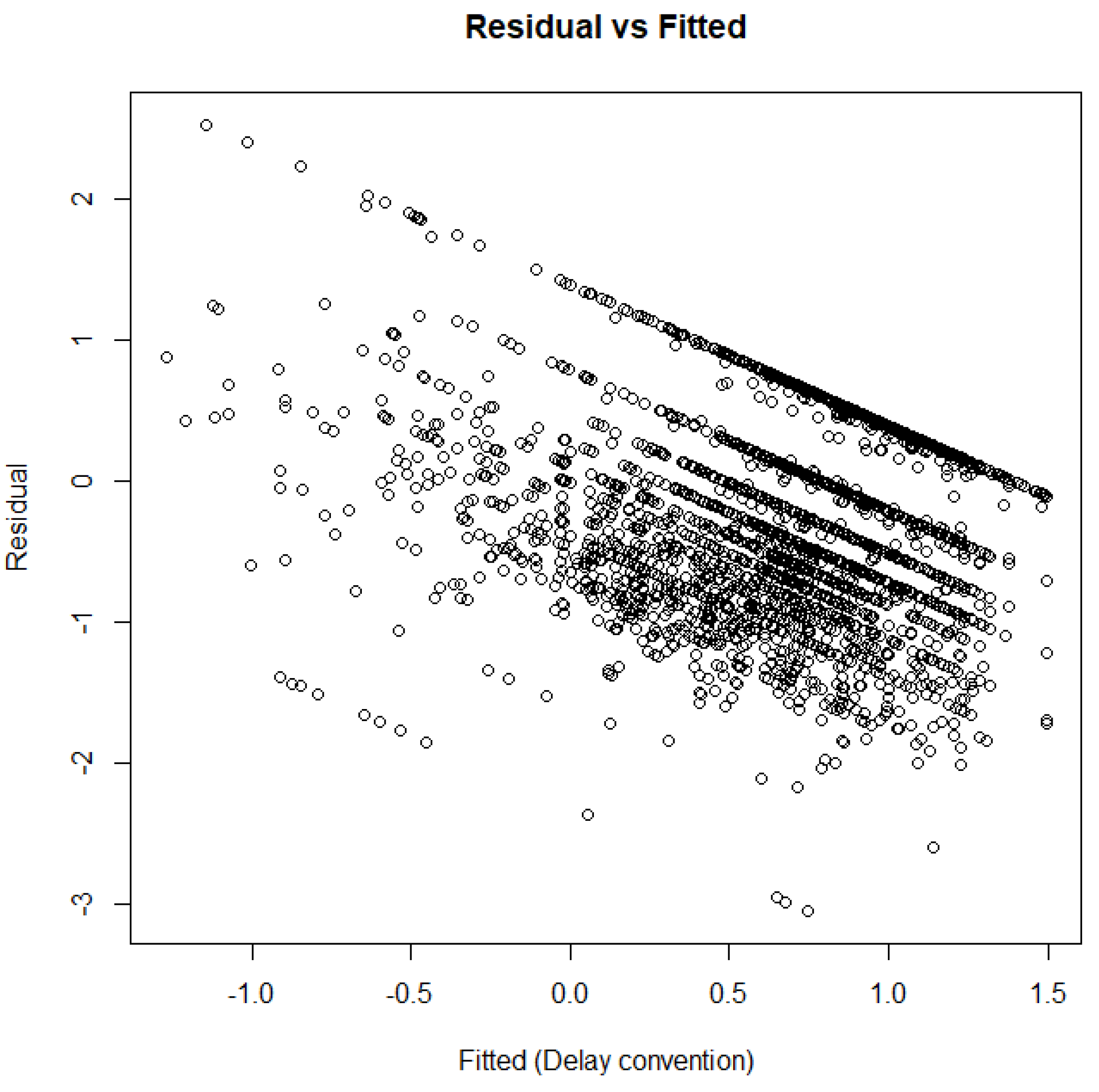
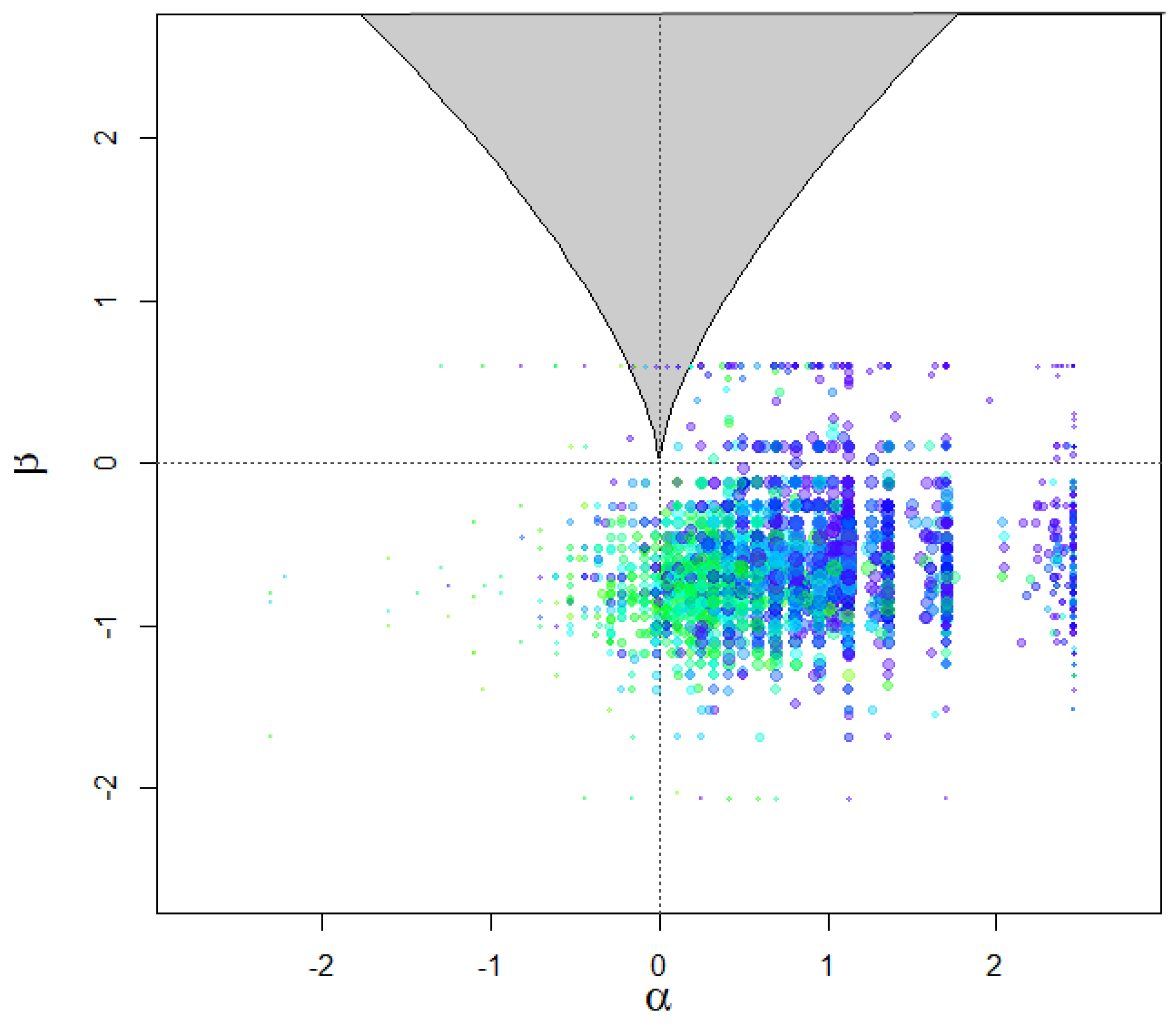
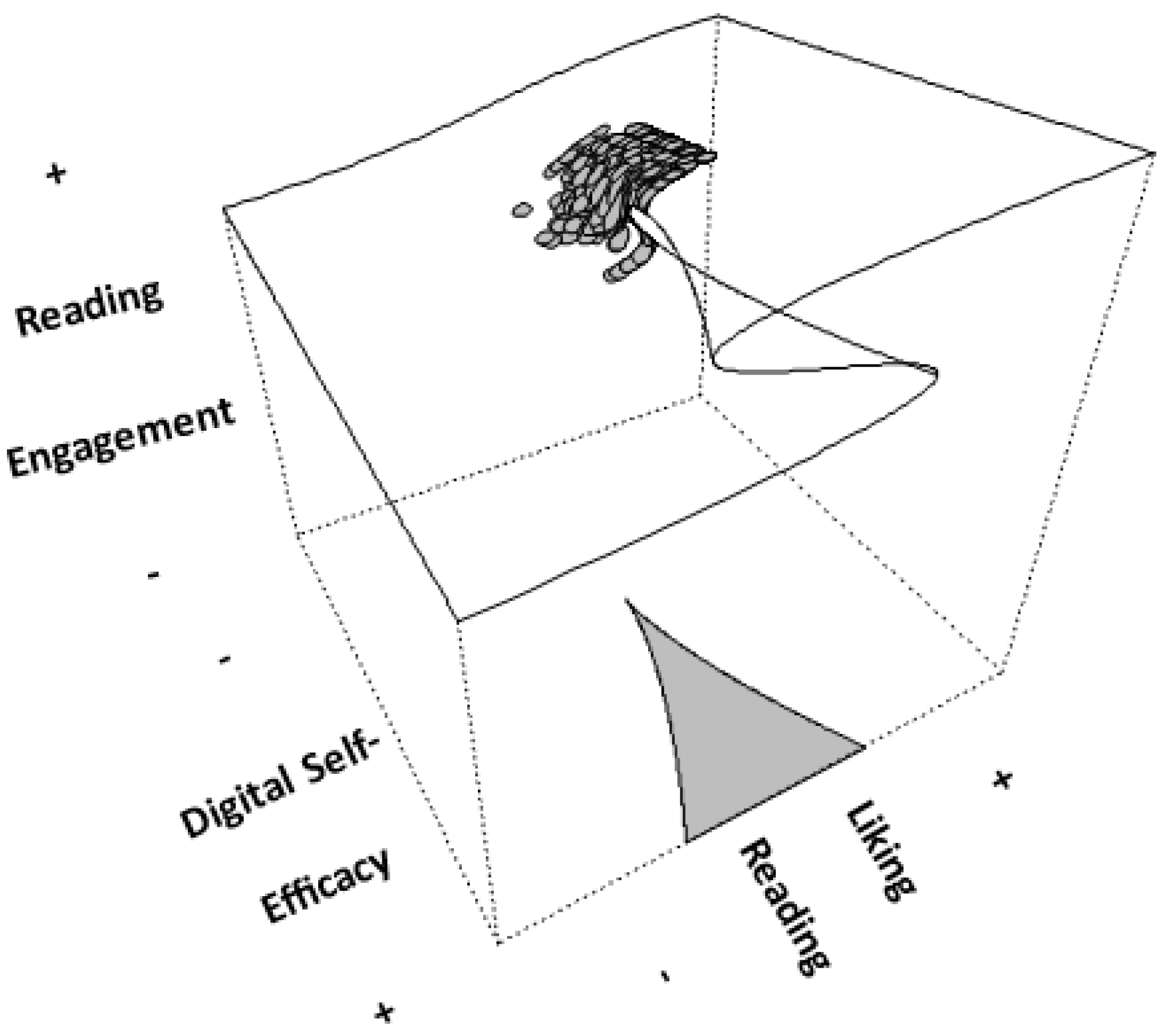
| Cusp Model Coefficients | Slope | S.E. | Z-Test | p-Value |
|---|---|---|---|---|
| a0 [Intercept] | −3.084 | 0.132 | −23.320 | <0.001 *** |
| a1 [Liking Reading] | 0.372 | 0.011 | 34.650 | <0.001 *** |
| b0 [Intercept] | −2.723 | 0.139 | −19.560 | <0.001 *** |
| b1 [Digital Efficacy] | 0.224 | 0.015 | 15.120 | <0.001 *** |
| w0 [Intercept] | −3.111 | 0.044 | −71.070 | <0.001 *** |
| w1 [Reading Engagement] | 0.338 | 0.003 | 97.700 | <0.001 *** |
| Models Tested | Loglikelihood | Parameters | AIC | AICc | BIC |
|---|---|---|---|---|---|
| 1. Linear | −6992.798 | 4 | 13,993.596 | 13,993.608 | 14,018.079 |
| 2. Logistic | −6950.741 | 5 | 13,911.482 | 13,911.500 | 13,942.085 |
| 3. Cusp | −4190.135 | 6 | 8392.269 | 8392.294 | 8428.993 |
Disclaimer/Publisher’s Note: The statements, opinions and data contained in all publications are solely those of the individual author(s) and contributor(s) and not of MDPI and/or the editor(s). MDPI and/or the editor(s) disclaim responsibility for any injury to people or property resulting from any ideas, methods, instructions or products referred to in the content. |
© 2025 by the authors. Licensee MDPI, Basel, Switzerland. This article is an open access article distributed under the terms and conditions of the Creative Commons Attribution (CC BY) license (https://creativecommons.org/licenses/by/4.0/).
Share and Cite
Alghamdi, M.; Sideridis, G. The Dual Role of Digital Self-Efficacy in Reading Engagement from a Nonlinear Dynamics Perspective. Children 2025, 12, 292. https://doi.org/10.3390/children12030292
Alghamdi M, Sideridis G. The Dual Role of Digital Self-Efficacy in Reading Engagement from a Nonlinear Dynamics Perspective. Children. 2025; 12(3):292. https://doi.org/10.3390/children12030292
Chicago/Turabian StyleAlghamdi, Mohammed, and Georgios Sideridis. 2025. "The Dual Role of Digital Self-Efficacy in Reading Engagement from a Nonlinear Dynamics Perspective" Children 12, no. 3: 292. https://doi.org/10.3390/children12030292
APA StyleAlghamdi, M., & Sideridis, G. (2025). The Dual Role of Digital Self-Efficacy in Reading Engagement from a Nonlinear Dynamics Perspective. Children, 12(3), 292. https://doi.org/10.3390/children12030292




